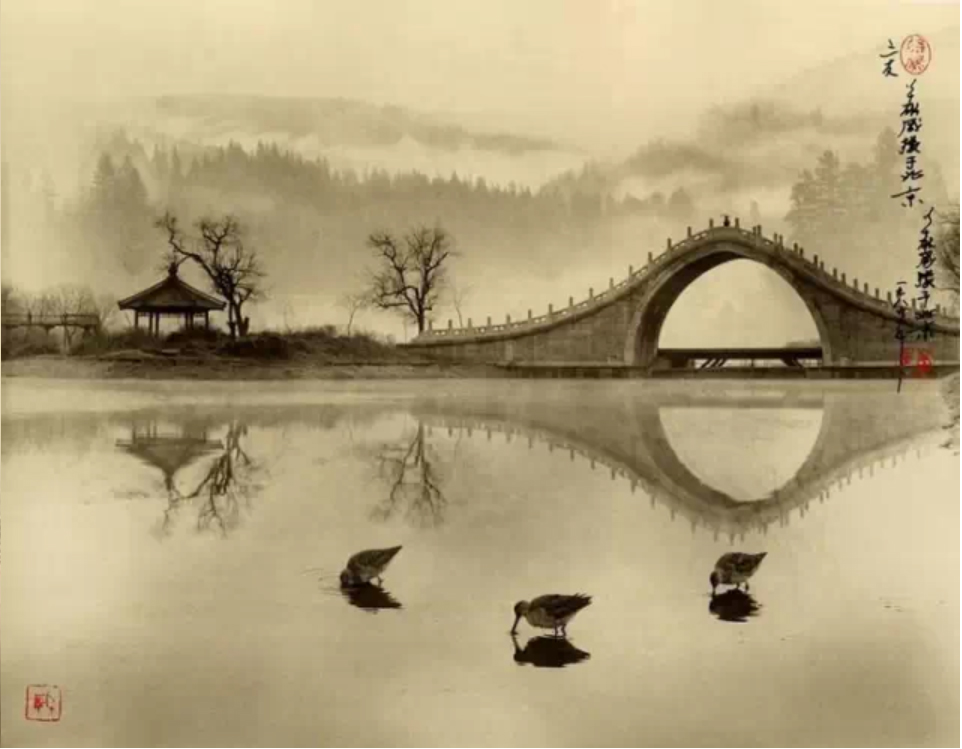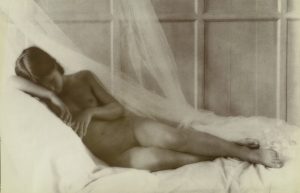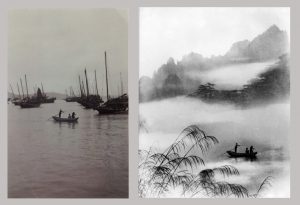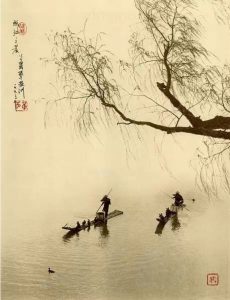
Dong Hong-Oai and Symbolism in Photography
(Guangzhou, 1929 – USA, 2004)
This is not a traditional Chinese painting. It is a photographic print. Still, it’s not exactly a photo. It is a composite photographic creation of world-renowned Chinese artist Dong Hong-Oai.
As a starter, one must understand that we cannot approach a culture with a history of 3,000 years lightly. The Chinese people have long claimed to have achieved perfection in the art of painting and drawing. Moreover, their long history of non-aggression towards neighboring countries has forged their peaceful social values, while “The Middle Kingdom” provided the entire artistic, philosophical, social and economic inspiration for the Chinese people.
Using a style known to some as Asian pictorialism, classical Chinese motifs are framed and superimposed to create the effect and feeling that a single photograph or painting can not provide. This fusion of disciplines is as unique and intriguing as Dong Hong-Oai’s life.
Born in Guangzhou in 1929, Dong Hong-Oai left home at the age of seven, after the sudden death of his parents. The youngest of twenty-four siblings, he was sent to the Chinese community of Saigon. There, he became an apprentice in a photography studio owned by Chinese immigrants and learned the basics of photography. During this period, he is particularly interested in landscape photography. At age 21, after a series of odd jobs, he joined the National University of Vietnam.
He stayed in Vietnam for most of the war during the 1970s, briefly traveling to France in 1974 to work with a former teacher who later died, and then to Malaysia to work as a photographer for the Red Cross. . Following a series of repressive policies targeting Chinese immigrants, Dong Hong-Oai became one of the millions of “boat people” who left Vietnam in the 1970s and 1980s.
At the age of 50, neither speaking English nor knowing anybody in America, he arrives in San Francisco. He sets up a small dark room and sells his photographs at street fairs. He can thus collect enough money to return periodically to China to take pictures of surreal landscapes and, more importantly, to study in 1980 under the tutelage of Long Chin-San in Taiwan.
Long Chin-San, this famous master, had been trained in the traditional art of painting Chinese landscapes. This art form does not seek to accurately portray nature, but to interpret the emotional impact of nature. Dramatic monochromatic landscapes, using simple brushes and ink, combine different forms of art – poetry, calligraphy and painting – and allow artists to experiment.
During his career, Long Chin-San abandoned his style of Impressionist painting to go towards photography. He developed a method of overlaying negatives to place components and subjects on three different plans. He taught this method to Dong Hong-Oai.
Seeking to better emulate the traditional Chinese style, Dong Hong-Oai has added calligraphy and seals to the images. In the 1990s, his new art inspired traditional paintings began to attract the attention of the art world. Soon, he no longer needs to sell his photographs in the street. Through an agent, his works are sold in galleries and museums in America, Europe and Asia. He was then in his sixties and for the first time in his life he was able to gain some financial stability.
Dong Hong-Oai died in 2004, at the age of 75. He left an incredible amount of works of Pictorialist inspiration. Dong Hong-Oai was one of the last photographers to work this way. He is also probably the best. He was honored by Kodak, Ilford and Fotokina in West Germany. He was also a member of the International Federation of Photographic Art in Switzerland and the Chinatown Photographic Society of San Francisco.
The influence of Dong Hong-Oai
The Long Chin-San Master
Long Chin-San (Lang Jingshan, born in Huai’an, Jiangsu Province, 1892 – Taipei 1995, at 102 years old) is a pioneering photographer and one of first Chinese photojournalists. His work is referred to as the best known in the history of Chinese art photography.
He became a member of the Royal Photographic Society in 1937. In 1980, the Photographic Society of America named him one of the top ten photographers in the world. He was the first Chinese photographer to take artistic nude photography, and was also known for a unique “composite photography” technique he had created.
At the age of 12, while studying at Shanghai’s Nanyang Middle School, he received his first photography training based on the principles of composition and photography techniques
Career
In 1911, Long began working for Shanghai’s Shen Bao newspaper in advertising design. In 1926, he moved to the Eastern Times newspaper as one of the first Chinese photojournalists. In 1928, he became a founding member of China Photography Association, China’s first art photography association, at Shanghai.

Meditation (1928), the oldest Chinese artistic nude photography.
Long’s work covers many facets. His commercial newspaper jobs have made him one of the first Chinese photojournalists, but his work in other fields has placed artistic values first. In 1928, he captured what was considered the oldest surviving Chinese artistic nude photograph, “Meditation” (the model’s father beat her when he heard what she had done).
In 1930, he published an album of nude photographs, the first in China. He exhibited his own work, including “After the Tang Masters” at the 1937 exhibition of the Royal Photographic Society and Majestic Solitude (1937) at the 1940 exhibition of the Royal Photographic Society.
Long Chin-San briefly experimented with the modernist style, like architectural photos highlighting abstract forms. On the other hand, the texture and composition of Long’s landscape photography is inspired by traditional Chinese landscape ink painting.
He obtained these effects by superimposing several images on a single print and using a brush and ink. He created several photography groups and organized a series of exhibitions that were also presented in Japan, the United States and England.

Majestic Solitude (1934), in the style of traditional Chinese ink painting
In 1939, Aurora University in Shanghai organized an exhibition of his works illustrating the concepts of Chinese painting in photography. When the Japanese occupied Shanghai during the Sino-Japanese War, he settled in the Sichuan Province and returned to Shanghai after the war.
With the takeover of control by the Communists of Mainland China, he moved to Taiwan in the summer of 1949, abandoning most of his photographic equipment. In March 1953, the China Photography Association was reinstated in Taipei and Lang was the director for a period of 42 years.
Beginning in the 1960s, Long Chin-San’s photographs focus on imaginary landscapes with chinese characters, many of which are inspired by paintings of Zhang Daqian’s Taoist influence. In 1968, he visited the United States and Kodak factories in New York State. In 1981 and 1983, he presents individual retrospectives in France and in 1984 in Hong Kong.
Style and influences
Long Chin-San was committed to teaching and spreading its ideas of Chinese photography. He was inspired by the pioneering photographer and poet writer Liu Bannong, who claimed in 1928 that China should have its own style rooted in Chinese culture.
In turn, he and his style influenced young photographers such as Liu Xucang and Tchan Fou-li, who worked in Hong Kong. He published an important article entitled ” Composite Images and Chinese Art ” in the journal of the Royal Photographic Society in February 1942.


Two examples of composite images of Long Chin-San
Long Chin-San’s influence on Dong Hong-Oai’s vision
Symbolism before realism
Dong Hong-Oai’s photographs were strongly influenced by the time spent under the direction of Long Chin-San photographer in Taiwan at the beginning of 1980s. Long Chin-San had developed a photographic style based on the tradition of Chinese landscape painting, which emphasized symbolism before realism and was interested in the artistic interpretation of a scene rather than to his faithful representation.
Traditional Chinese landscape painting has more in common with classical poetry than documentary-style painting from Europe from the Middle Ages.
The realism of Western paintings was simply not what the Chinese consider an artistic expression. They see it as a commercial practice, not an artistic creation. According to Chinese inspiration, artists must not simply reproduce what is before them, but rather go beyond the visible image to discover the deeper links with the human emotions.
It is this sensibility that Long Chin-San, and later Dong Hong-Oai, transposed into their photographic work.
Asian Pictorialism and Long Chin-San
The Asian pictorialist style uses symbolism and composite montage to evoke the photographer’s reaction to a scene. The scene is built, rather than captured, using traditional motifs such as birds, boats, mountains and water to convey the vision of the artist. The vast tradition of Chinese art and poetry was therefore invoked to give a final, more allegorical and allusive photograph than a mere faithful image.
This distinction between realism and symbolism is perhaps even more important in photography. The originality of Dong Hong-Oai’s work lies in the production of an imaginary scene giving it a realistic character.

Even more than his Long Chin-San mentor, Dong Hong-Oai’s images are faithful to the composition elements of traditional landscape painting.
Use of space
What we notice in Dong Hong-Oai’s images is the use of space and the positioning of the elements in the composition. Images of boats and branches, for example, never seem to invade space. The frame is always filled. It’s a minimalist landscape, but perfectly composed.

Long Chin-San and Zhang Daqian: A century of friendship
Zhang Daqian, the recurring hero of most of Long’s works, was one of the most famous painters of the twentieth century in the traditional field of ink and water . Like Long Chin-San, although a few years earlier, in the 1920s, Zhang made a name for himself in Shanghai. The two men developed a strong and sustained friendship.
Zhang helped Long to forge his photographic language. It was Zhang who introduced him to the Mountains Huangshan: the picturesque peaks of eastern China have inspired many masters of landscape painting and captivated photographers with their atmospheric beauty. These magnificent mountains became immediately a lasting inspiration for Long Chin-San and have inspired him in his creation of composite photography.
From his first trip to Huangshan, Long Chin-San returned to Shanghai to perform some of his first attempts at composite photography. He returned there five times and these summits continued to have a place in his subsequent works. One of his first mountains was photographed during his first trip. This is a composite image from a Zhang Shanzi negative sitting in front of Qipingsong and other photographic and painted elements.

The late brother of Zhang Daqian, as represented by Long Chi-San in the Huangshan Mountains.
Thirty years later, in 1962, Zhang Daqian wrote an inscription on this print: “My late second brother, Shanzi, went to Huangshan at the age of 51. Mr. Long Chin-San took a picture of him in front of Mount Qipingsong. ” Written while Zhang was living in Brazil – and about the same time Long made many portraits of Zhang.” This is a note commemorating a fundamental point in their career and their lives.
Wikepedia Commons, Art of Long Chin-San
Painting by Zhang Daqian, showing Taoist influence
Liu Bannong, photographer and poet
References
The “Emulative” Portraits: Long Chin-San’s Photography of Zhang Daqian By Mia Yinxing Liu
Photographies of Long Chin-San
China’s first nude photographer By Zhang Junmian
Symbolism
Valley of the great Yangtze river
Chinise paintion of the 14th century
Painting of sceneries by Zhao Wuchao


No Comments